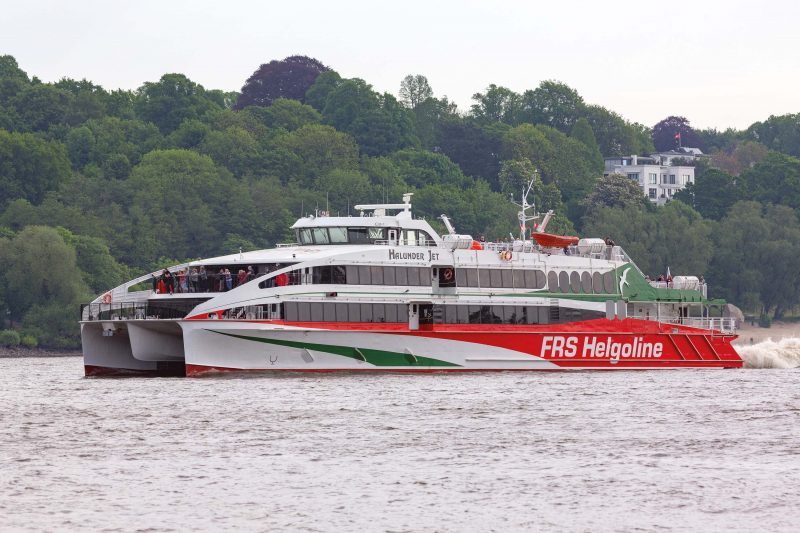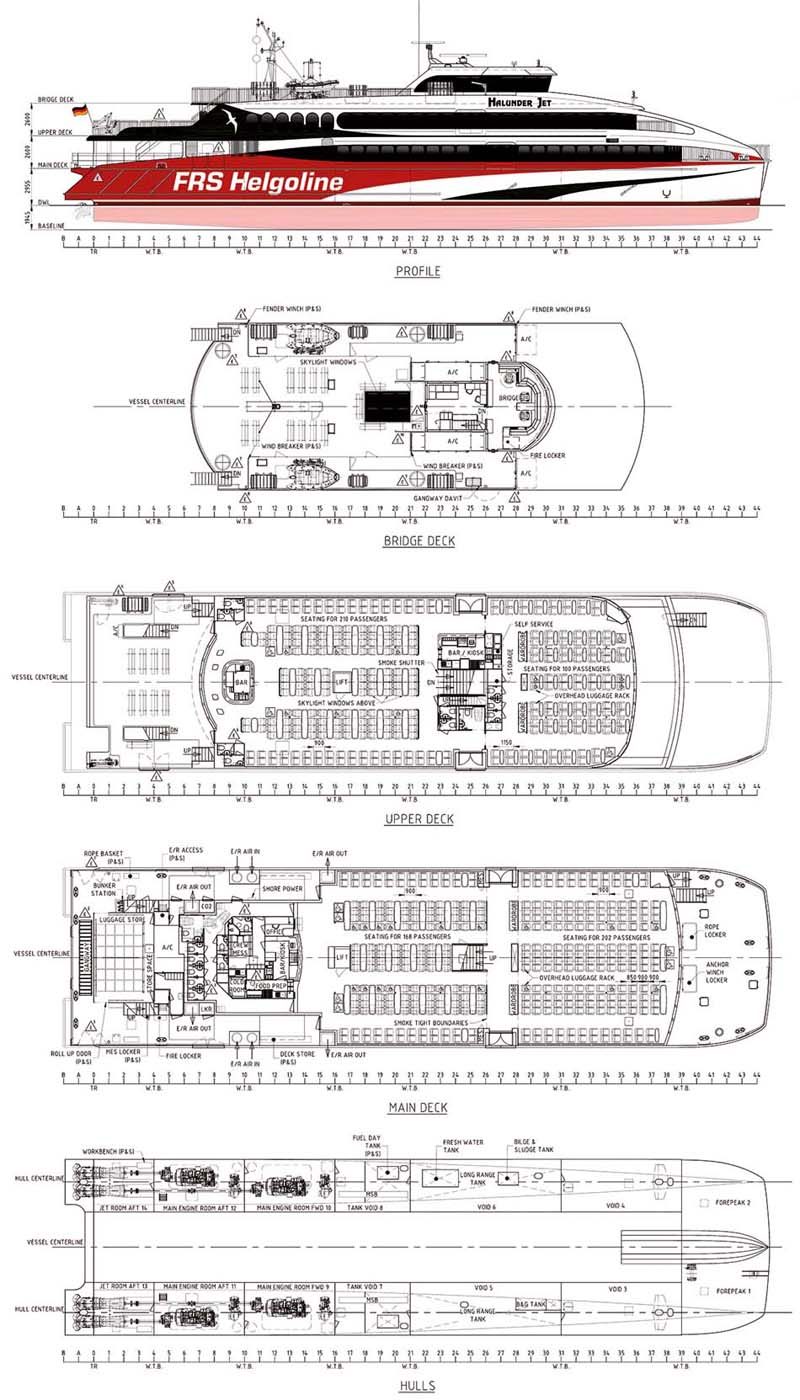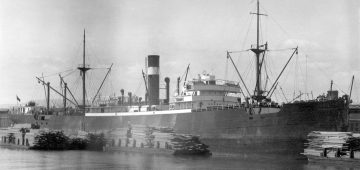
Förde Reederei Seetouristik started out as a regional passenger ferry operator founded in 1866 and now the Flensburg, Germany, based company has grown into an international business group and is one of Europe’s leading ferry operators. Nowadays FRS provides both conventional ferry high speed ferry services and, with 64 vessels and approximately 1,500 employees worldwide, the group transports around 8 million passengers and 2.2 million vehicles per annum. FRS now comprises approximately 25 subsidiaries located in Europe, North Africa, the Middle East and North America. With a core business of national and international ferry operations, the parent company also now specialises in Offshore Logistics, Port Management, Crewing and Maritime Consulting.
This newbuild feature concentrates on the Förde Reederei Seetouristik service offered from Hamburg to Germany’s only offshore island, Heligoland. In 1984 what is now FRS took over the Heligoland traffic from KG Seetouristik and, in 1991, Förde Reederei GmbH and KG Seetouristik GmbH & Co. merged to form Förde Reederei Seetouristik GmbH & Co. KG (FRS). The Hamburg-Heligoland service now trades as FRS Heligoline GmbH & Co. KG and is the market leader to the island, conveying over 165,000 passengers annually. Heligoland is located 29 miles off the German coastline in the German Bight region of the North Sea and consists of two islands, the populated triangular 0.4 sq mile island of Hauptinsel to the west, and the 0.27sq. mile Düne to the east. The island of Hauptinsel is what the place name Heligoland is normally used to refer to and the smaller island is not permanently inhabited. Although culturally closer to North Frisia in the German district of Nordfriesland, the two islands are part of the district of Pinneberg in the state of Schleswig-Holstein. Heligoland was a colony of the British Empire 1807-1890, has a population of around 1,100 people and is a holiday resort that enjoys Duty Free status, as it is part of the EU but excluded from the EU VAT area and customs union. Consequently, much of the economy is founded on sales of duty free merchandise to tourists who visit the islands. An airport is situated on Düne with the main island boasting a harbour frequented by private craft plus the seasonal passenger ferry services from both Cuxhaven and Hamburg operated by FRS and Cassen-Eils, with the latter also providing a year-round link from Cuxhaven.
The Hamburg-Heligoland high speed passenger ferry era dawned in 1997 when Speedways opened a service using the Vargøy, a 41m long, 477gt and 342 passenger capacity vessel built by Kvaerner Fjellstrand A/S of Norway. FRS joined this fast ferry trade from Hamburg in May 1998 when the 41m long, 466gt and 342 passenger capacity Baltic Jet, a near sister to the Vargøy, entered service. The vessel was then renamed Hanse Jet II. As these operations established themselves, the first fast ferry service to Heligoland from Cuxhaven, and also Austal Ship’s first 52m passenger catamaran, joined the party. Operated by Norden-Frisia, the 920gt and 432 passenger capacity Cat No.1 entered service on 9th March 1999. The vessel’s full sphere of operation was Cuxhaven-Heligoland- Norderney-Langeoog-Borkum-Eemshaven-Amrum-Hörnum. In 2006 she was sold to Linda Line, Tallinn, as the Merilin and in 2017 moved on to South Korea for a new career with Daezer Shipping Co. Ltd., Pohang. When these ferry services blossomed in the 1990s there was another rapid transit service along the River Elbe to/from Hamburg, namely Elbe City Jet Schnellfahren. Craft employed included the Hanseblitz, Hansepfeil and Hansestar.
On 6th July 2002 FRS began trials using the larger Fjellstrand A/S built Flying Viking between Hamburg’s Landungsbrücken and Heligoland. In 2003 FRS took delivery of the 910gt/52m long and double-deck Fjellstrand (Norway) built Halunder Jet, a slightly larger version of the Flying Viking, for the Hamburg-Wedel-Cuxhaven-Heligoland service. The new arrival, with a passenger capacity of 579, entered service on 13th May 2003. The displaced Hanse Jet II was redeployed on a Cuxhaven-Heligoland service in May 2003 for the summer but this was not continued. The introduction of the Halunder Jet also saw Speedways bow out as the new vessel could carry more than the combined capacity of the Vargøy and Hanse Jet II. The competing craft would also have been shadowing each other on near identical departure times so Speedways effectively handed the Hamburg-Heligoland market to FRS. The Halunder Jet operated the shuttle service to Heligoland each summer season until October 2017, completing 22,000 hours of reliable operation, powered by MTU Series 4000 engines. Both the Vargøy and Hanse Jet II were eventually sold on for further service in Turkey and Greece respectively. The Halunder Jet (1) made her last round trip to Heligoland on 15th October 2017 after 15 years in service and departed Hamburg for the last time on 3rd November 2017 after refit at Blohm & Voss. She was renamed Victoria Clipper V and was shipped to Canada to join the FRS Group’s Seattle (USA) to Victoria (Canada) route, operated by Clipper Navigation. The need for greater capacity here was the catalyst for the project to build Halunder Jet (2). At this point it is worth mentioning the background to the choice of name for the 2003 built craft. Halunder (or Heligolandic) is the dialect of the North Frisian language spoken on Heligoland. It is still spoken today by some 500 of the island’s 1,650 inhabitants and is also taught in schools. Heligolandic is closely related to the insular North Frisian dialects of Fering and Öömrang. Heligolandic also contains a variety of loanwords from 19th-century Modern English due to the 83-year British control of the island.
New Vessel, Same Name
On 14th December 2016 Förde Reederei Seetouristik signed a contract with Austal for a new 56.40m long and 692 passenger capacity catamaran representing a contract price of €15.47 million and providing work for a workforce of 250 (including 60 Austal and 17 FRS employees). Destined to continue the name of Halunder Jet, Yard No. H418 began to grow at the Austal Philippines Pty. Ltd. shipyard in Cebu, Philippines, where the keel laying took place on 26th June 2017. The newbuild’s beam is 14m with a hull depth of 4.90m and draught of 1.99m. The shallow draught characteristic is essential for operating in the more confined sections of the route.
As mentioned above, Austal Limited first had a product operating to Heligoland in 1999. The company was previously known as Austal Ships and is a global defence prime contractor and a designer and manufacturer of defence and commercial vessels. Based in Henderson, Australia, Austal has been a leader in the design, construction and maintenance of revolutionary ships for governments, navies and ferry operators around the world for over 28 years now with in excess of 255 vessels delivered in that time. Austal Philippines, where the new FRS vessel was built, commenced operations in February 2012 as part of a competitive strategy by Austal to regionalise its manufacturing base for commercial vessels. The shipyard began with 30 employees and now boasts a workforce of over 300. The Austal Philippines shipyard in Balamban, Cebu, was acquired in November 2011 and a comprehensive refurbishment programme was implemented to establish best-practice facilities enabling production that meets Austal’s high standards. The shipyard is now the Austal Group’s global centre for commercial vessel design, development and construction and is strategically positioned to cater to market demands for high speed ferries, work boats, fast crew transfer boats and other commercial vessels. Austal Philippines delivered its first vessel, a 27m Tri-Swath Wind Farm support vessel, to the UK in January 2013 and has since produced a variety of craft. In response to demand for its products, Austal Limited embarked upon a US$30 million investment programme for capacity expansion during May. This outlay is focused in the Company’s commercial shipbuilding facilities in Western Australia and Asia. After conducting an extensive analysis, Austal selected its existing Philippines and Henderson shipyards for the capacity expansion. Works have commenced and will be funded from Austal’s ongoing money reserves. Completion of the expansion projects is expected during 2018 at Henderson and in early 2019 in the Philippines. At present, Austal’s Henderson facility is constructing a $100 million, 109-metre high speed catamaran ferry for Molslinjen of Denmark and will shortly commence construction of the first of two 117-metre trimarans for Fred. Olsen Express, worth a combined $190 million, destined for the Canary Islands. The A$6 million capital investment to upgrade the facilities at Henderson include enhanced launch facilities to support large vessel construction and infrastructure upgrades to support improved efficiency across the operations. In Cebu, Austal is investing circa US$18m to more than double the capacity of its existing Philippines shipyard. The upgrades to the facilities include a new assembly hall that will be 120m long, 40m wide, and 42m high. This will enable the shipyard to assemble the largest commercial vessels, based on Austal’s existing order book and tender pipeline. Austal Philippines currently has in production a 109m high speed catamaran for Fjordline of Norway, worth $108 million, two 50m high speed vessels for Braveline worth $44 million, a 49m vessel for SNC Aremiti worth $30 million and a 30m vessel for VS Grand Tours, worth $5 million. Austal has also recently opened a small commercial shipyard at Vung Tau, Vietnam to build smaller high speed aluminium vessels.

The all-new 52m Austal passenger catamaran series design ordered by FRS encompasses several key innovations including an optimised hull form that will minimise both fuel consumption and wake wash when operating on the River Elbe between the Port of Hamburg and the estuary at Cuxhaven. The environmentally friendly ship has been designed with several features to improve passenger comfort with the use of energy efficient LED lighting technologies internally and externally to create mood, ambient and decorative lighting. Large windows in the superstructure and two open deck areas offer passengers expansive views from throughout the vessel. During the development of the twin-hulled vessel, both the shipping company and the shipyard focused their attention in particular on seaworthiness and passenger comfort. The all-aluminium catamaran also features silicon type anti-fouling (with no biocides that can harm waterways), a sewage treatment plant and an engine exhaust arrangement that will allow catalytic converters to remove nitrous oxides from the main engine exhaust. The FRS Group contract represented Austal’s 6th commercial ferry order in 2016.
Rolls-Royce was contracted to provide four 16-cylinder MTU Series 4000 engines and four Kamewa S71 waterjets for Yard No. H418. The Förde Reederei Seetouristik Shipping Group has favoured MTU products for many years now with the previous Halunder Jet, plus a further 7 high-speed ferries operated by the group on international ferry and catamaran routes, all being powered by MTU’s Series 4000, 2000 and 396 engines. The Series 4000 Ironmen engines were selected due to their common rail fuel injection system that makes them very economical and environmentally friendly.
The units installed are four 16V MTU 4000 M63L engines generating 2,240kW each at 1800rpm. These engines measure 2,990mm long, 1,850mm wide and 2,070mm high and have a 170mm bore and a 210mm stroke. Renowned for being extremely robust, the Series 4000 Ironmen version of the 4000 engine series was developed in 2008 and is particularly popular among operators for its extended maintenance intervals and low fuel consumption. Their dynamic acceleration behaviour was also a key factor for installation in a fast ferry. Each engine drives a Rolls Royce KaMeWa 71 S4 waterjet via ZF 7650 ZF Friedrichshafen AG gearboxes.

The steel series waterjets each have a 4,500kW output and are designed to be easy to install in hulls constructed from different materials. These new Kamewa waterjets provide improved efficiency over a wider speed range. The stainless steel mixed flow pump is now even more efficient and the waterjet is also some 15% lighter whilst a new bucket design improves steering and reversing. Onboard power is provided by four D5A TA AB Volvo Penta units. The 35 knot vessel has increased the passenger capacity of each trip from Hamburg by 20% compared to her predecessor. The machinery spaces are in the aft 33% of the hulls with the remaining space occupied by fuel, freshwater and bilge tanks plus 14 void spaces.
The passenger areas on the Halunder Jet are located on two decks with the light and airy interiors being designed by the renowned Spear Green Design of Australia. The new vessel offers more space for passengers than her predecessor, more comfort and panoramic windows through each lounge space. Seating is divided into three categories as follows: Jet Class has seating for 378 passengers through two thirds of the main deck. Aft of the seating is a Bar/Kiosk plus the galley and Crew Mess. On the stern is the luggage store. Above on the Upper Deck, Premium Class offers 100 seats in the forward passenger lounge with overhead storage compartments, an exclusive open air balcony located forward and pantry service. All non-alcoholic drinks are also complimentary for Premium Class passengers. Aft of this lounge is a bar/kiosk. The rear section of the upper deck is the 210 seat Panorama Class lounge with skylights above the central rows of seating. A bar is located at the aft end along with access to a large sun deck with seating. Another such sun deck is located atop the upper passenger deck, aft of the wheelhouse. The navigation bridge itself is much more spacious and a small conference room is located behind it for use during internal meetings. Seating is of a Pullman style in all lounges and at-seat catering service is offered. Widescreen TVs throughout the vessel show the actual position of the craft vessel and also provide travel and destination information. The luggage handling service is the same as on the old catamaran with an upper deck mounted crane at the stern hoisting luggage trolleys on and off the vessel.
Epic Delivery
The new Halunder Jet was launched on 7th January 2018 and she was handed over to FRS at the shipyard in Cebu on 7th March 2018. On this day the ferry embarked upon a 10,294 nautical mile (19,065km) delivery voyage under her own power, no piggyback vessel was employed. The catamaran crossed the South China Sea, the Indian Ocean, the Gulf of Aden and the Red Sea. After a three-week stay in the Spanish Port of Algeciras due to bad weather the vessel finally reached Hamburg on 23rd April and, after trials and training, she was christened at Hamburg’s St. Pauli Landungsbrücken on 27th April by 16-year-old Heligoland resident Jana-Pauline Toben. The first revenue earning round trip to Heligoland was made on 28th April and thus a new chapter for the service began.
Special thanks must go to Förde Reederei Seetouristik and Marko Stampehl for assistance with the information, images and diagrams.

TECHNICAL SPECIFICATIONS
| Contract Date | 14th December 2016 |
| Contract Value | €15.47 million |
| Keel Laid | 26th June 2017 |
| Launched | 7th January 2018 |
| Delivery | 7th March 2018 |
| Service Debut | 28th April 2018 |
| Shipyard | Austal Philippines Pty. Ltd. |
| Place of build | Cebu, Philippines |
| Yard No | H418 |
| Owner | Larouzio Shipping Co. Ltd. |
| Operator | FRS Shipmanagement Ltd. |
| Service | Hamburg-Wedel-Cuxhaven-Heligoland (March-October) |
| IMO | 9825295 |
| Flag | Cyprus |
| Port of Registry | Limassol |
| Classification | 455 High Speed Passenger Catamaran 1A HSLC Passenger E0 R2 |
| Length Overall | 56.40m |
| Length (b.p.) | 53.00m |
| Beam | 14.00m |
| Hull Depth (Moulded) | 4.90m |
| Hull draught | 1.99m |
| Gross Tonnage | 1,231 |
| Deadweight | 96 |
| Net Tonnage | 441 |
| Main Engines | 4x 16V MTU 4000 M63L engines generating 12,182 horse power (8,960 KW) |
| Gearboxes | 4x ZF 7650 ZF Friedrichshafen AG |
| Waterjets | 4x Rolls Royce KaMeWa 71 S4 waterjets |
| Auxiliary Engines | 4x D5A TA AB Volvo Penta units |
| Ride Control | Fitted |
| Service Speed | 35 knots |
| Fuel | MGO |
| Operating Limits | 3m Maximum Wave Height |
| Passenger Capacity | 692 maximum |
| Passenger Facilities | Passenger Lounge – Premium (100 seats), Panorama (202 seats) and Jet Class (378 seats), Pullman Seating throughout, Bar (upper deck in Premium Class), Sun Deck, At-seat catering service, 12 Wheelchair paces |
| Crew | 16 |




Comments
Sorry, comments are closed for this item